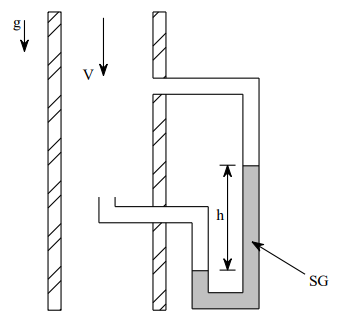
Elements Of Electromagnetics
7th Edition
ISBN: 9780190698614
Author: Sadiku, Matthew N. O.
Publisher: Oxford University Press
expand_more
expand_more
format_list_bulleted
Concept explainers
Question
Water flows down in the vertical pipe shown below. Assuming inviscid flow, derive an expression for this velocity of the water V, in terms of the manometer reading h, the specific gravity of the gage fluid SG, and the acceleration of gravity g.

Transcribed Image Text:In the diagram, we have a U-shaped tube, which is slightly unconventional. On the left, there's a wider channel labeled with downward arrows. The first arrow is marked "g," likely representing gravitational acceleration. The second arrow, labeled "V," suggests velocity.
To the right of this, the U-shaped structure is shown. In the left section of the U-tube, there's a horizontal pipe connecting it to a vertical tube that starts from the top. The vertical portion of this tube is indicated with arrows pointing downward, and it is partially filled with a fluid shaded in gray. The height of the fluid within this section is marked by "h."
The label "SG" is placed within the shaded gray area in the vertical section, which possibly stands for "Specific Gravity," indicating the density-related property of the fluid compared to a reference substance, typically water.
This entire setup appears to be demonstrating a concept related to fluid dynamics, such as Bernoulli’s principle or hydrostatic pressure, by showing how velocity and gravity interact within the conduit system.
Expert Solution
arrow_forward
Step 1: Introduction
To derive the expression for velocity for the above drawing.
Given the acceleration due to gravity is
manometric deflection is
velocity of water,
Step by stepSolved in 4 steps with 11 images

Knowledge Booster
Learn more about
Need a deep-dive on the concept behind this application? Look no further. Learn more about this topic, mechanical-engineering and related others by exploring similar questions and additional content below.Similar questions
- AB is a section in a 25 centimeter constant diameter pipe. 20 degree C mercury enters the section at speed 8 meters/sec. Flow is steady-state. Determine the net force on the mercury in section AB in Newtons.arrow_forwardWater flows steadily through a horizontal 30 degree pipe bend. At the inlet point 1, the diameter is 0.3 m, the velocity is 12 m/s, and the pressure is 128 kPa gauge. At the outlet point 2, the diameter is 0.38 m and the pressure is 145 kPa gauge. Determine the forces F_x and F_y necessary to hold the pipe stationary.arrow_forwardThe diameter of a pipe changes gradually from 75 mm at a point A, 6 m above datum, to 150 mm at B, 3 m above datum. The pressure at A is 103 kPa and the velocity of flow is 3.6 m/s. Neglecting losses, with the aid of a neat sketch, determine the pressure at Barrow_forward
- A turbine with a power coefficient Cp = 0.28 is able to generate 2.1 MW of electrical power with blades of length R =75 m. What is the value of the wind speed? Calculate the value in meters/second and round off to two decimal places. Do not write the unit.arrow_forwardIn a system where the Froude model will be used, the flow rate for the prototype is given as 3 m3 / s. In the model, the velocity at point A is 0.2 m / s and the force acting on point A is calculated as 1 N. Calculate the flow rate and velocity of the point corresponding to point A in the model and the magnitude of the force affecting the same point. Determine the pressure scale. The geometric scale will be taken as 1/100. Fluids used in the model and prototype are the same and are waterarrow_forwardWater steam is running through the nozzle. Inlet pressure is P1=25 bars; T1=300C; V1=90m/s; A1=0.2m2. The exit parameters are: P2=11bars; T2=210C. The mass flow rate is m=2 kg/s. Determine: a.Exit velocity V2=?; b.Inlet and outlet diameters D1 and D2.arrow_forward
arrow_back_ios
arrow_forward_ios
Recommended textbooks for you
 Elements Of ElectromagneticsMechanical EngineeringISBN:9780190698614Author:Sadiku, Matthew N. O.Publisher:Oxford University Press
Elements Of ElectromagneticsMechanical EngineeringISBN:9780190698614Author:Sadiku, Matthew N. O.Publisher:Oxford University Press Mechanics of Materials (10th Edition)Mechanical EngineeringISBN:9780134319650Author:Russell C. HibbelerPublisher:PEARSON
Mechanics of Materials (10th Edition)Mechanical EngineeringISBN:9780134319650Author:Russell C. HibbelerPublisher:PEARSON Thermodynamics: An Engineering ApproachMechanical EngineeringISBN:9781259822674Author:Yunus A. Cengel Dr., Michael A. BolesPublisher:McGraw-Hill Education
Thermodynamics: An Engineering ApproachMechanical EngineeringISBN:9781259822674Author:Yunus A. Cengel Dr., Michael A. BolesPublisher:McGraw-Hill Education Control Systems EngineeringMechanical EngineeringISBN:9781118170519Author:Norman S. NisePublisher:WILEY
Control Systems EngineeringMechanical EngineeringISBN:9781118170519Author:Norman S. NisePublisher:WILEY Mechanics of Materials (MindTap Course List)Mechanical EngineeringISBN:9781337093347Author:Barry J. Goodno, James M. GerePublisher:Cengage Learning
Mechanics of Materials (MindTap Course List)Mechanical EngineeringISBN:9781337093347Author:Barry J. Goodno, James M. GerePublisher:Cengage Learning Engineering Mechanics: StaticsMechanical EngineeringISBN:9781118807330Author:James L. Meriam, L. G. Kraige, J. N. BoltonPublisher:WILEY
Engineering Mechanics: StaticsMechanical EngineeringISBN:9781118807330Author:James L. Meriam, L. G. Kraige, J. N. BoltonPublisher:WILEY

Elements Of Electromagnetics
Mechanical Engineering
ISBN:9780190698614
Author:Sadiku, Matthew N. O.
Publisher:Oxford University Press

Mechanics of Materials (10th Edition)
Mechanical Engineering
ISBN:9780134319650
Author:Russell C. Hibbeler
Publisher:PEARSON

Thermodynamics: An Engineering Approach
Mechanical Engineering
ISBN:9781259822674
Author:Yunus A. Cengel Dr., Michael A. Boles
Publisher:McGraw-Hill Education

Control Systems Engineering
Mechanical Engineering
ISBN:9781118170519
Author:Norman S. Nise
Publisher:WILEY

Mechanics of Materials (MindTap Course List)
Mechanical Engineering
ISBN:9781337093347
Author:Barry J. Goodno, James M. Gere
Publisher:Cengage Learning

Engineering Mechanics: Statics
Mechanical Engineering
ISBN:9781118807330
Author:James L. Meriam, L. G. Kraige, J. N. Bolton
Publisher:WILEY